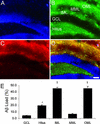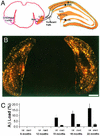Amyloid deposition in the hippocampus and entorhinal cortex: quantitative analysis of a transgenic mouse model
- PMID: 12697936
- PMCID: PMC153642
- DOI: 10.1073/pnas.0330745100
Amyloid deposition in the hippocampus and entorhinal cortex: quantitative analysis of a transgenic mouse model
Abstract
Various transgenic mouse models of Alzheimer's disease (AD) have been developed that overexpress mutant forms of amyloid precursor protein in an effort to elucidate more fully the potential role of beta-amyloid (A beta) in the etiopathogenesis of the disease. The present study represents the first complete 3D reconstruction of A beta in the hippocampus and entorhinal cortex of PDAPP transgenic mice. A beta deposits were detected by immunostaining and thioflavin fluorescence, and quantified by using high-throughput digital image acquisition and analysis. Quantitative analysis of amyloid load in hippocampal subfields showed a dramatic increase between 12 and 15 months of age, with little or no earlier detectable deposition. Three-dimensional reconstruction in the oldest brains visualized previously unrecognized sheets of A beta coursing through the hippocampus and cerebral cortex. In contrast with previous hypotheses, compact plaques form before significant deposition of diffuse A beta, suggesting that different mechanisms are involved in the deposition of diffuse amyloid and the aggregation into plaques. The dentate gyrus was the hippocampal subfield with the greatest amyloid burden. Sublaminar distribution of A beta in the dentate gyrus correlated most closely with the termination of afferent projections from the lateral entorhinal cortex, mirroring the selective vulnerability of this circuit in human AD. This detailed temporal and spatial analysis of A beta and compact amyloid deposition suggests that specific corticocortical circuits express selective, but late, vulnerability to the pathognomonic markers of amyloid deposition, and can provide a basis for detecting prior vulnerability factors.
Figures





Similar articles
-
Cholinergic neuropathology in a mouse model of Alzheimer's disease.J Comp Neurol. 2003 Aug 4;462(4):371-81. doi: 10.1002/cne.10737. J Comp Neurol. 2003. PMID: 12811807
-
Deposition of mouse amyloid beta in human APP/PS1 double and single AD model transgenic mice.Neurobiol Dis. 2006 Sep;23(3):653-62. doi: 10.1016/j.nbd.2006.05.010. Epub 2006 Jul 10. Neurobiol Dis. 2006. PMID: 16829076
-
Decreased adult hippocampal neurogenesis in the PDAPP mouse model of Alzheimer's disease.J Comp Neurol. 2006 Mar 1;495(1):70-83. doi: 10.1002/cne.20840. J Comp Neurol. 2006. PMID: 16432899
-
Molecular and anatomical studies in Alzheimer's disease.Neurologia. 2001 Mar;16(3):100-4. Neurologia. 2001. PMID: 11333778 Review.
-
Neurodegenerative Alzheimer-like pathology in PDAPP 717V-->F transgenic mice.Prog Brain Res. 1998;117:327-34. Prog Brain Res. 1998. PMID: 9932418 Review.
Cited by
-
A kinetic aggregation assay allowing selective and sensitive amyloid-β quantification in cells and tissues.Biochemistry. 2011 Mar 15;50(10):1607-17. doi: 10.1021/bi1013744. Epub 2011 Jan 26. Biochemistry. 2011. PMID: 21268584 Free PMC article.
-
Differential expression of proteins in brain regions of Alzheimer's disease patients.Neurochem Res. 2014 Jan;39(1):208-15. doi: 10.1007/s11064-013-1210-1. Epub 2013 Dec 4. Neurochem Res. 2014. PMID: 24306222
-
Activation of phagocytic activity in astrocytes by reduced expression of the inflammasome component ASC and its implication in a mouse model of Alzheimer disease.J Neuroinflammation. 2016 Jan 27;13:20. doi: 10.1186/s12974-016-0477-y. J Neuroinflammation. 2016. PMID: 26818951 Free PMC article.
-
Effect of Aging on the Viscoelastic Properties of Hippocampal Subfields Assessed with High-Resolution MR Elastography.Cereb Cortex. 2021 May 10;31(6):2799-2811. doi: 10.1093/cercor/bhaa388. Cereb Cortex. 2021. PMID: 33454745 Free PMC article.
-
Bidirectional metabolic regulation of neurocognitive function.Neurobiol Learn Mem. 2011 Nov;96(4):507-16. doi: 10.1016/j.nlm.2011.01.004. Epub 2011 Jan 12. Neurobiol Learn Mem. 2011. PMID: 21236352 Free PMC article. Review.
References
-
- Price D L, Sisodia S S. Annu Rev Neurosci. 1998;21:479–505. - PubMed
-
- Hardy J, Selkoe D J. Science. 2002;297:353–356. - PubMed
-
- Sommer B. Curr Opin Pharmacol. 2002;2:87–92. - PubMed
-
- Masliah E, Rockenstein E. J Neural Transm (Suppl.) 2000;59:175–183. - PubMed
-
- Dodart J C, Mathis C, Saura J, Bales K R, Paul S M, Ungerer A. Neurobiol Dis. 2000;7:71–85. - PubMed
MeSH terms
Substances
LinkOut - more resources
Full Text Sources
Other Literature Sources
Medical
Molecular Biology Databases

